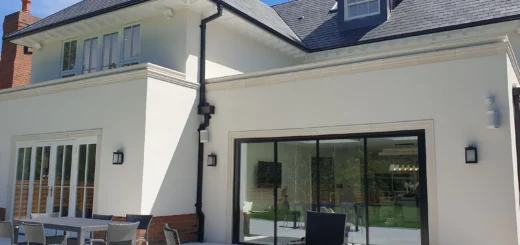Glass Interior Doors: Types, Styles & Materials
Table of Contents
Why Choose Glass Interior Doors?
Glass interior doors strike a perfect balance between openness and privacy in modern British homes. Light travels freely through even closed doors, making your spaces feel larger and more connected while maintaining clear room boundaries. Unlike solid doors that block views and create dark corridors, these doors keep sight lines open without sacrificing the practical benefits of separate rooms.
Creating Brighter Spaces
Natural light turns dark hallways and north-facing rooms into bright, welcoming areas. Interior doors with glass panels let sunshine reach deep into your home, reducing the need for artificial lighting during daylight hours. In period properties with traditional layouts, these doors help preserve the original room structure while solving common lighting challenges.
Sound Control Without Walls
Modern double-glazed interior glass doors provide surprisingly effective sound insulation. The gap between glass panes absorbs noise, letting you maintain quiet zones without building solid barriers. Home offices and music rooms benefit particularly from this acoustic control, as conversations and activities in adjacent spaces remain muffled yet visible.
Smart Space Division
Glass interior doors offer practical ways to zone living areas without losing the sense of space. A partially frosted door between a kitchen and dining room maintains privacy while cooking yet allows you to keep an eye on children or guests. The level of privacy varies with different glass types – from fully transparent to completely opaque – giving you control over visibility between spaces.
Room layouts become more flexible when you can see through doorways. Furniture placement near glass doors feels natural since you can spot potential obstacles, while the visual connection helps small rooms feel less confined. Modern style homes often feature interior glass doors as central design elements, using them to create distinct zones that still feel connected to the wider space.
Types of Glass Interior Doors and Their Best Uses
Different door mechanisms suit different spaces and needs within your home. Glass interior doors come in several operating styles, each with its own advantages and space requirements. The right choice depends on your room layout, available wall space, and how you use each area.
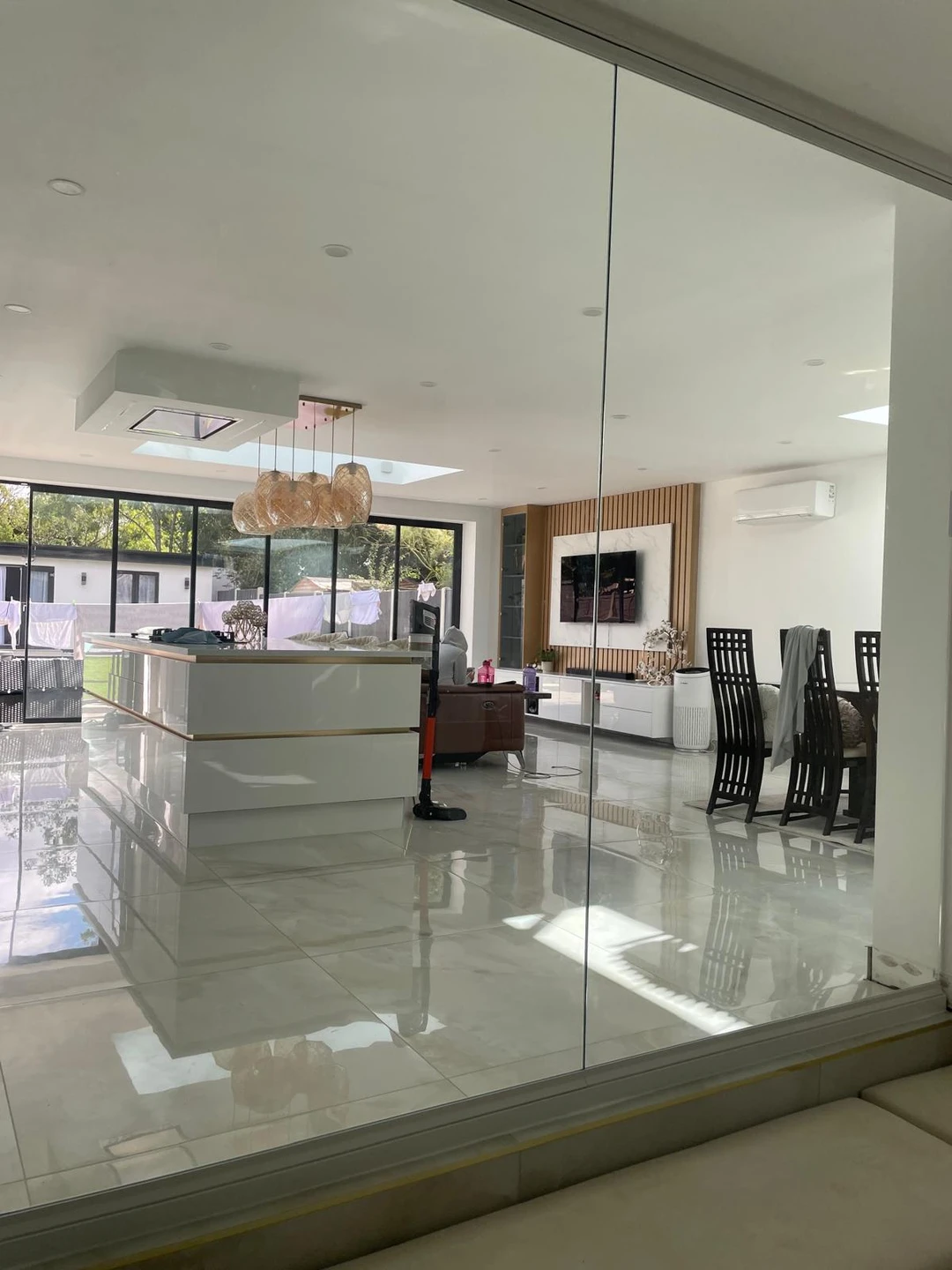
Sliding Glass Interior Doors
Interior glass sliding doors move smoothly along tracks mounted above the opening. These doors need wall space equal to the door width on one side, yet take up no floor space when open. Heavy glass panels glide effortlessly on high-quality rollers, making them practical for daily use in busy areas like kitchens or home offices.
Double doors with sliding mechanisms work well in wider openings, creating an impressive entrance between living spaces. The panels can stack behind each other when open, revealing the full width of the doorway. Premium sliding systems include soft-close mechanisms that prevent slamming and protect the glass.
Glass panels in sliding doors often reach from floor to ceiling, making the most of natural light. While standard sizes suit most openings, made-to-measure options accommodate unusual dimensions or period properties with non-standard heights.
Pivot Doors
Large pivot doors turn on vertical pins rather than hinges, creating a striking focal point. The pivot point sits offset from the door edge, allowing the panel to rotate smoothly even at substantial sizes. These doors particularly suit modern homes with open-plan layouts.
Internal glass doors with pivot mechanisms need careful planning for clearance zones. As the door swings, it occupies space on both sides of the opening. The reward for this space requirement is a door that moves with remarkable grace, despite its size.
Pocket Doors
Sliding interior glass doors that disappear completely into wall cavities offer the ultimate space-saving solution. Pocket doors require specific wall construction to house the door when open, making them ideal for new builds or major renovations.
The mechanics of pocket systems involve precision-engineered tracks that ensure smooth operation year after year. While installation costs exceed surface-mounted options, the clean look and space efficiency often justify the investment.
Hinged Interior Glass Doors
Traditional hinged mechanisms remain popular for glass interior doors, offering reliable operation and wide opening angles. French doors exemplify this style, with two panels meeting in the middle of wider openings. These doors suit both period and contemporary homes, working equally well in formal reception rooms or as dividers between living spaces.
Quality hinged systems include adjustable components that maintain perfect alignment over time. Proper installation ensures the weight of glass panels doesn’t cause sagging or alignment issues, while draft excluders keep air movement between rooms under control.
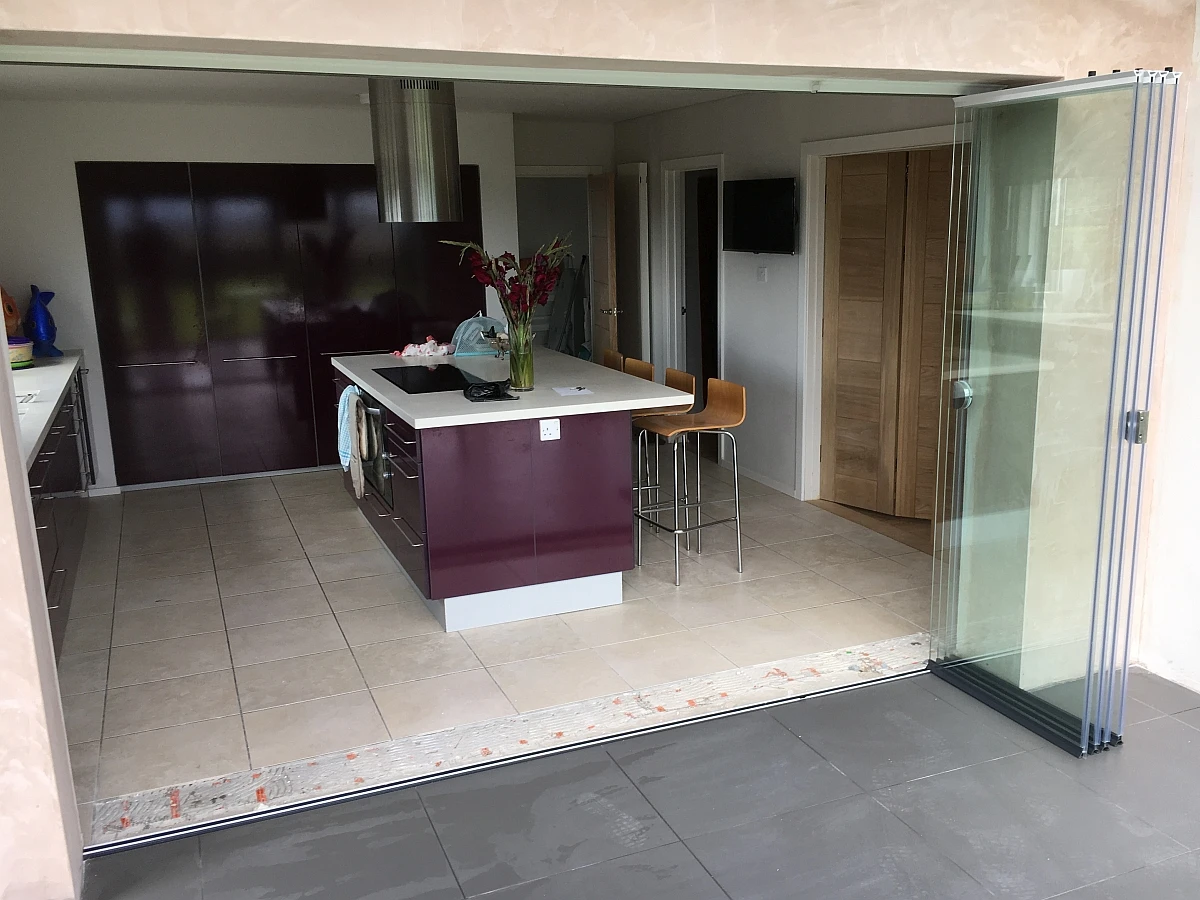
Bifold Doors
Bifold internal doors with glass fold neatly against the wall, making them perfect for wide openings where space is limited. Each panel connects to the next with hinges, creating a concertina effect when opened. These systems work particularly well between dining rooms and conservatories, or to separate large living areas.
The flexibility of bifold doors shows in their various configurations:
- Two-panel systems for standard doorways
- Three or four panels for wider openings
- Multiple panels for room-width installations
When closed, bifold doors create a wall of glass that lets light flow between spaces. The panels stack neatly to one or both sides when open, requiring minimal projection into the room. High-quality hardware ensures these complex mechanisms work smoothly despite frequent use.
Planning Your Glass Interior Doors
The right glass interior doors create visual harmony while solving practical challenges in your home. Each design choice affects both the look and usability of your space, from frame styles to glass finishes and hardware options.
Glass Patterns and Privacy
Frosted glass offers privacy without blocking light, ideal for bathrooms and bedrooms. The opacity level varies with different etching techniques, letting you choose exactly how much visibility to allow through your interior doors with glass. Fine-lined patterns create subtle screening effects, while heavy frosting blocks all but silhouettes.
Living room internal sliding doors often feature clear glass to maintain open sight lines. In spaces where privacy needs change throughout the day, switchable glass panels turn from transparent to opaque at the touch of a button. These electronic systems cost more than standard glass but provide unmatched control over visibility.
Patterned glass adds visual interest while diffusing light in interesting ways. Textured surfaces range from subtle ripples to bold geometric designs, each creating different effects as natural light passes through. These patterns work particularly well in spaces where you want partial screening without full privacy.
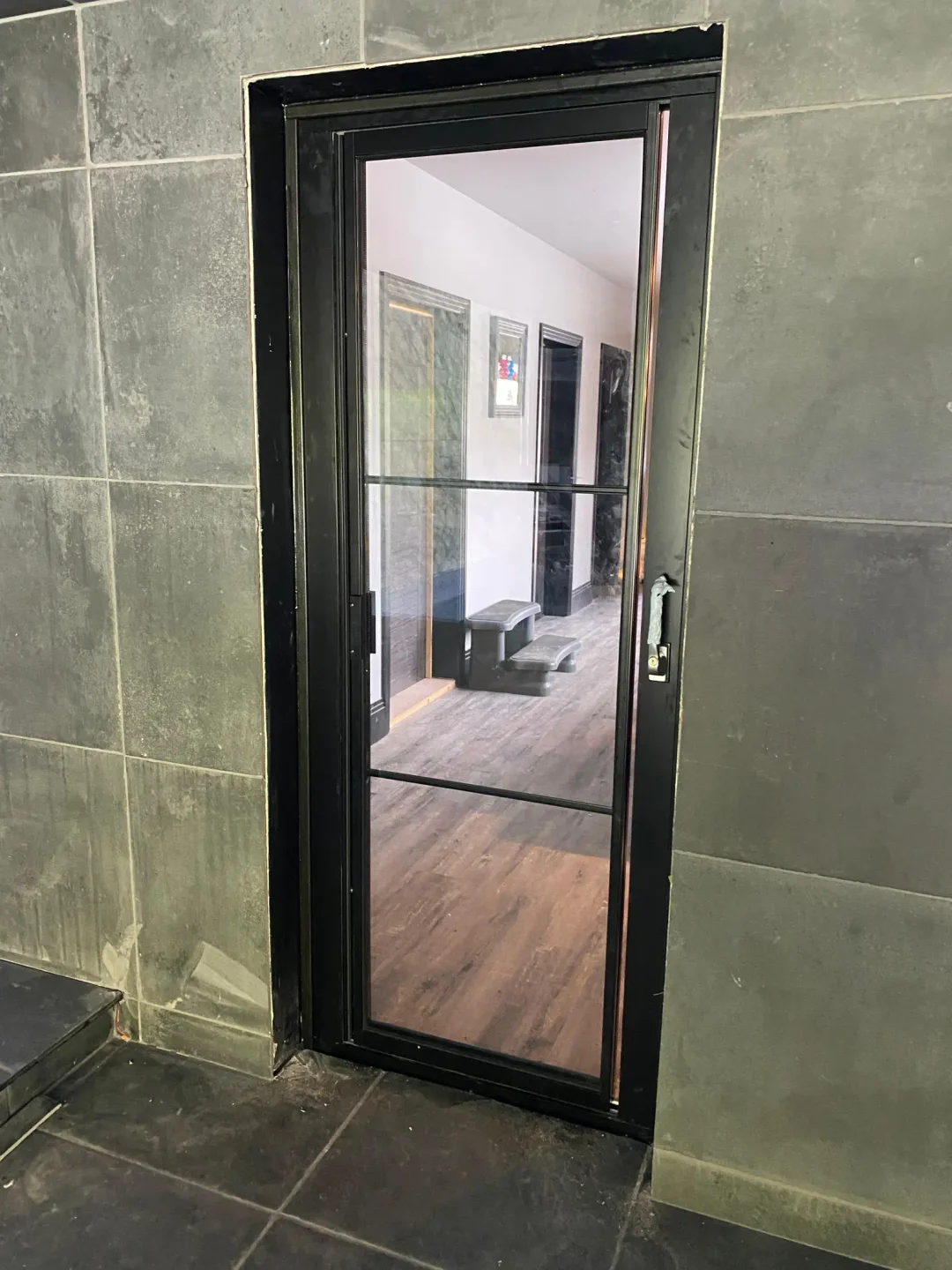
Handles and Hardware
Hardware choices affect both the look and operation of your glass interior doors. Sleek handle designs in brushed steel or matte black complement contemporary glass panels, while brass or chrome suits traditional settings. The handle mechanism needs to suit the door’s weight and size, ensuring easy operation despite heavy glass panels.
Pull handles on sliding systems should be comfortable to grip and positioned at the right height for all users. Locks and latches need careful selection too – some provide simple privacy functions while others offer full security for home offices or valuable storage areas.
Frame Choices Matter
Frame designs shape the character of glass interior doors, from minimal aluminium sections to substantial timber surrounds. Slimline internal bifold doors with narrow frames put the focus on the glass itself, while wider frames make a stronger architectural statement.
Black frames against clear glass create a distinctive look that suits both period and modern homes. The contrast between frame and glass draws attention to the door as a design feature, rather than trying to hide it. Powder-coated aluminium offers dozens of colour options beyond standard black and white, letting you match or contrast with your interior scheme.
Working with Natural Light
Toughened safety glass comes in different clarity levels that affect how light moves through your home. Standard glass has a slight green tint that becomes noticeable in thicker panels, while low-iron glass offers perfect clarity at a higher cost.
Glass interior doors work best when positioned to make the most of available daylight. North-facing rooms benefit from clear glass that lets in maximum light, while south-facing spaces might need solar control glass to prevent overheating. The position of artificial lighting matters too – wall lights near glass doors can create unwanted reflections or glare at night.
Glass and Frame Materials Guide for Interior Glass Doors
The materials used in glass interior doors affect their safety, durability, and appearance. Quality materials ensure your doors perform well for years while meeting building regulations and safety standards.
Safety Glass Options
Toughened glass forms the basis of most interior doors with glass panels. This specially treated material breaks into small, rounded pieces rather than sharp shards if damaged. The strengthening process makes the glass up to five times stronger than standard glass, allowing for larger panels and slimmer frames.
Modern safety standards require specific glass types in different locations:
- Toughened glass in high-traffic areas
- Laminated glass near floor level
- Fire-rated glass in certain doorways
Laminated glass sandwiches a tough plastic layer between two glass sheets. If broken, the glass stays in place rather than falling, making it ideal for glass interior doors in family homes. The plastic layer also helps reduce noise transmission and blocks harmful UV rays.
Frame Materials
Aluminium frames combine strength with slim profiles, letting you fit larger glass panels safely. These lightweight yet robust frames resist warping and need little maintenance beyond occasional cleaning. Powder-coated finishes in hundreds of colours let you match any interior scheme.
Traditional style wooden frames bring warmth and character to period properties. Hardwoods like oak and maple resist wear while complementing existing joinery. Though requiring more upkeep than metal, timber frames can be refinished to look new again years later.
Steel frames offer industrial style with exceptional strength. Their narrow profiles suit minimalist designs, while their durability makes them popular in busy households. Galvanised and powder-coated finishes protect against corrosion, ensuring long-term performance.
Special Glass Types
Glass options for interior doors go beyond basic safety glass. Low-iron glass removes the slight green tint found in standard glass, creating crystal-clear views. This premium option suits doors where perfect clarity matters, like those leading to dining rooms or living spaces.
Acoustic glass combines multiple layers to reduce sound transmission between rooms. This specialist glass helps create quiet zones in busy homes, ideal for home offices or music rooms. The extra thickness adds weight but doesn’t affect the door’s appearance.
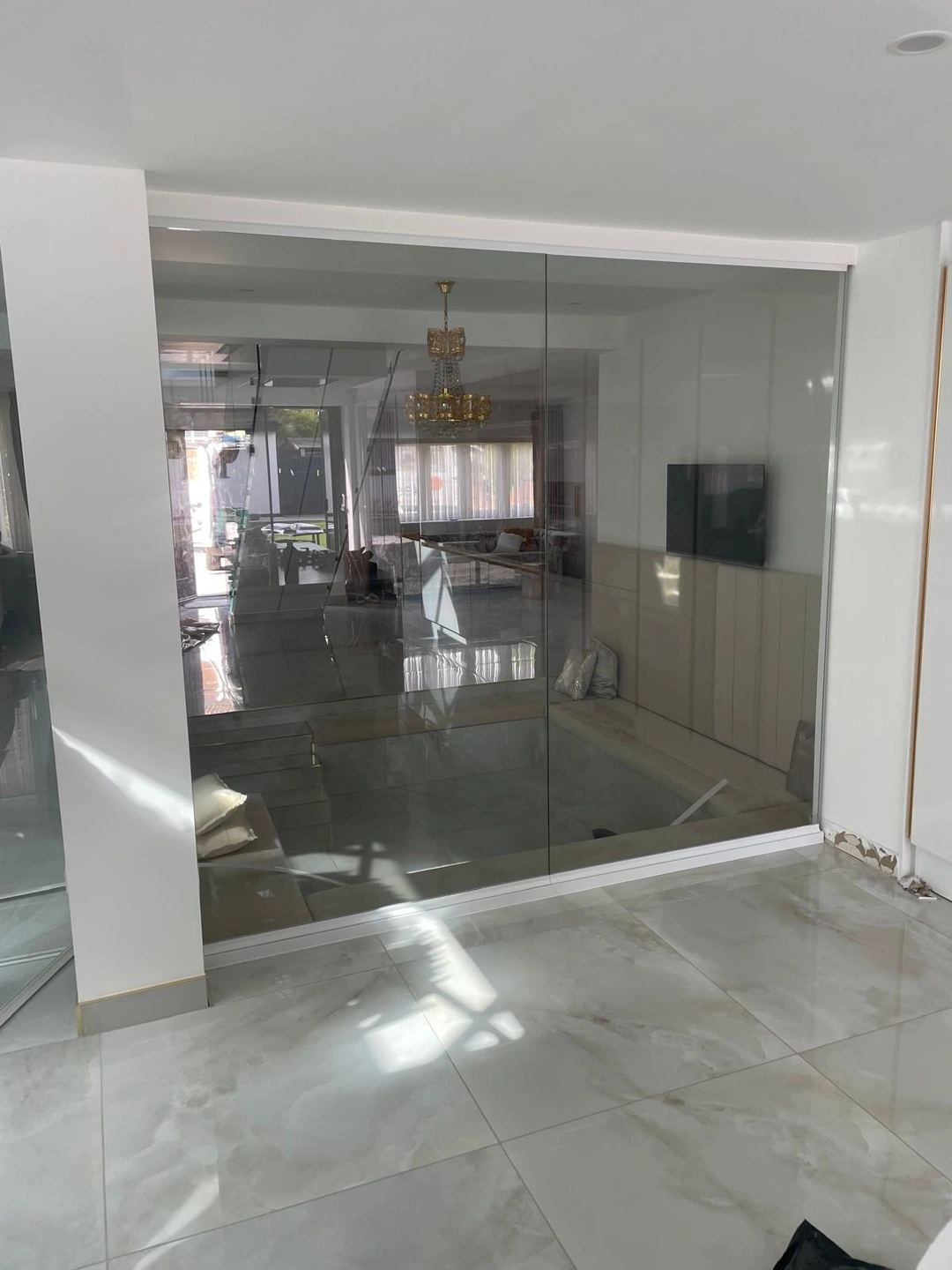
Glass Thickness
Panel size determines the required glass thickness in interior doors. Larger panels need thicker glass to prevent flexing and ensure smooth operation.
The frame type also influences glass thickness choice. Frameless designs typically need thicker glass since the edges aren’t supported, while fully framed doors can use thinner panels. The right balance between glass thickness and frame design ensures doors operate smoothly while meeting safety requirements.
Proper glass specification matters particularly in wider openings, where weight and structural support need careful calculation. Thicker glass increases sound insulation but adds considerable weight, requiring robust hinges or sliding mechanisms.
Glass Interior Doors in Commercial Spaces
Glass interior doors serve distinct purposes in business settings, from creating quiet work areas to defining customer spaces. Their ability to maintain visual connections while controlling noise and access makes them invaluable in modern workplaces.
Office Partitions
Glass office partition walls combine doors and fixed panels to create flexible workspaces. Interior doors with glass panels maintain acoustic privacy while letting natural light reach deep into office floors. Mid-height partitions topped with glass sections balance privacy at desk level with an open feel above, reducing the closed-in sensation of traditional solid walls.
Sound-rated glass systems help manage noise in busy offices without blocking sight lines. Double-glazed panels with wider air gaps absorb more sound, while specially laminated glass adds extra acoustic protection for meeting rooms and private offices.
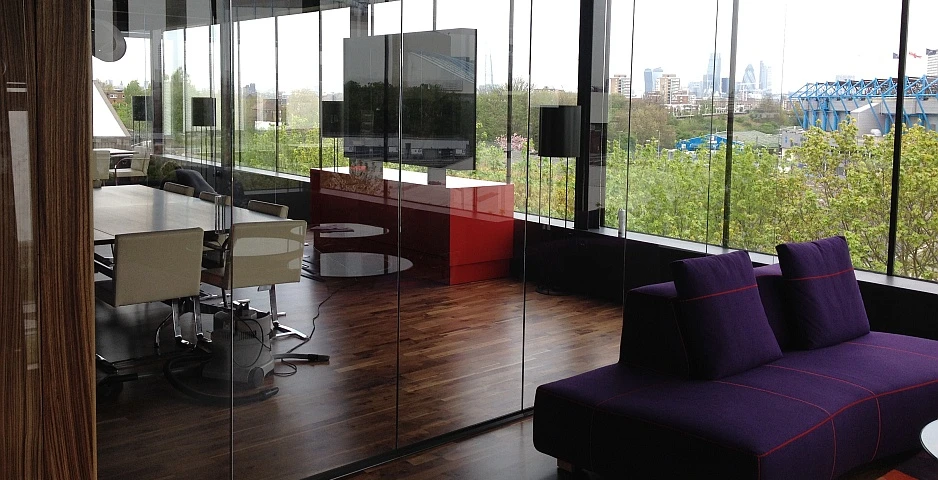
Teams can see when colleagues are available without interrupting focused work. This visual connection promotes collaboration while maintaining the benefits of separate spaces. Manifestation patterns or corporate branding applied to the glass add privacy and reinforce company identity.
Retail Applications
Shop layouts benefit from the visibility that glass interior doors provide. Staff can monitor multiple areas while keeping stock secure, and customers can easily spot available changing rooms or service desks. Clear glass maintains sight lines to merchandise, while frosted sections create privacy where needed.
Mobile partition systems with glass doors let shops adjust their layouts seasonally or for special events. The doors slide or fold away completely when open space is needed, then close to create separate departments or sale areas during normal trading.
Restaurant Settings
Dining zones divided by interior glass doors help restaurants manage noise and temperature while maintaining atmosphere. Private dining rooms feel connected to the main space yet offer acoustic separation for special events or business meetings.
Glass screens with integrated doors let restaurants adjust their covers according to demand. These movable walls can separate large tables or create intimate dining spaces, adapting the room layout throughout service. The transparency helps staff monitor all areas while preserving each zone’s distinct ambiance.
Meeting Rooms
Modern offices need meeting spaces that balance privacy with openness. Interior doors with glass panels let colleagues see when rooms are occupied without disrupting discussions inside. Switchable glass offers instant privacy for sensitive meetings at the touch of a button.
Sliding systems prove particularly useful in meeting rooms, taking up no swing space when open. This allows furniture placement right up to the doorway, making the most of limited floor area. Full-height glass maintains visual connection with the wider office while providing necessary acoustic separation.
Write-on glass surfaces integrated into door panels create impromptu brainstorming spaces. These practical surfaces double as screening when notes or diagrams are displayed, adding extra functionality to the glass barriers. Smart glass systems can even switch between clear, frosted, and projection modes, adapting to different meeting needs throughout the day.
Glass Interior Doors FAQ
Are glass interior doors safe for homes with children?
Glass interior doors use toughened safety glass that breaks into small, rounded pieces rather than sharp shards. Modern safety standards require laminated glass in areas near floor level, which holds together even if broken, while manifestation patterns help prevent accidental collisions.
What’s the difference between toughened and laminated glass?
Toughened glass undergoes heat treatment to increase its strength, making it break into small, safe pieces if damaged. Laminated glass sandwiches a tough plastic layer between glass sheets, holding everything together even when broken and offering better sound insulation.
Do interior glass doors block sound effectively?
Glass interior doors with double-glazed panels and proper seals provide good sound insulation between rooms. The air gap between panes absorbs noise, while laminated glass adds extra acoustic protection – thicker glass and wider air gaps improve performance further. Special acoustic glass can rival solid doors for sound blocking.
Are interior doors with glass more expensive than solid ones?
Basic glass interior doors cost roughly the same as mid-range solid timber doors. Premium options with features like switchable privacy glass or oversized panels cost substantially more, though prices vary widely based on size, glass type, and frame materials. Installation costs remain similar for both types.
What glass types offer the most privacy?
Fully frosted glass provides complete privacy while still letting light through. Textured patterns and acid-etched designs offer varying levels of screening, while switchable glass lets you change from clear to opaque instantly.
How long do glass interior doors last?
Quality glass interior doors last decades with proper care. The glass panels themselves don’t degrade, though frames may need occasional maintenance and hardware might require replacement after years of heavy use.
Can interior glass doors be fitted in period properties?
Glass interior doors work well in period homes when chosen carefully. Traditional frame styles and appropriate glass patterns help them complement original features, while modern sliding or pivot systems can add contemporary touches without compromising character. This flexibility makes them suitable for both restoration projects and modern updates in older properties.
How much light do frosted glass doors let through?
Light transmission through frosted glass varies from about 60% to 90% depending on the etching depth and pattern density. A medium frost strikes an ideal balance between privacy and brightness.
What’s the best frame colour for glass interior doors?
White doors remain a popular choice for their clean, timeless appeal, while anthracite grey suits contemporary spaces. Black frames create striking contrast with clear glass, and dual colour options let you match different room schemes on each side. The frame colour choice often depends on your interior style and the amount of attention you want the doors to attract.
What causes glass interior doors to stick?
Glass interior doors might stick due to misaligned tracks, worn rollers, or debris in sliding mechanisms. Temperature changes can affect frame materials differently than glass, occasionally causing temporary sticking that resolves once temperatures stabilise. Regular cleaning and maintenance of tracks and rollers prevents most issues.
How do you stop glass doors slamming?
Soft-close mechanisms prevent slamming by automatically slowing the door’s movement in its final closing stage. These devices can be retrofitted to most door types and protect both the glass and frame from damage.
What’s the best frame material for glass interior doors?
Glass interior doors perform best with aluminium or steel frames in high-traffic areas, offering strength without bulk. While timber frames bring warmth and character to period properties, they need more maintenance than metal alternatives. Modern composite frames combine the benefits of multiple materials, providing excellent thermal performance and durability with minimal upkeep requirements, though they typically cost more than single-material options.
About SunSeeker Doors
With over 20 years of experience, SunSeeker Doors remains at the forefront of door design with our quality-tested patio doors and related products, including the bespoke UltraSlim aluminium slide and pivot door system, Frameless Glass Doors, and Slimline Sliding Glass Doors. All of our doors are suitable for both internal and external use.
To request a free quotation, please use our online form. You may also contact 01582 492730, or email info@sunseekerdoors.co.uk if you have any questions.




